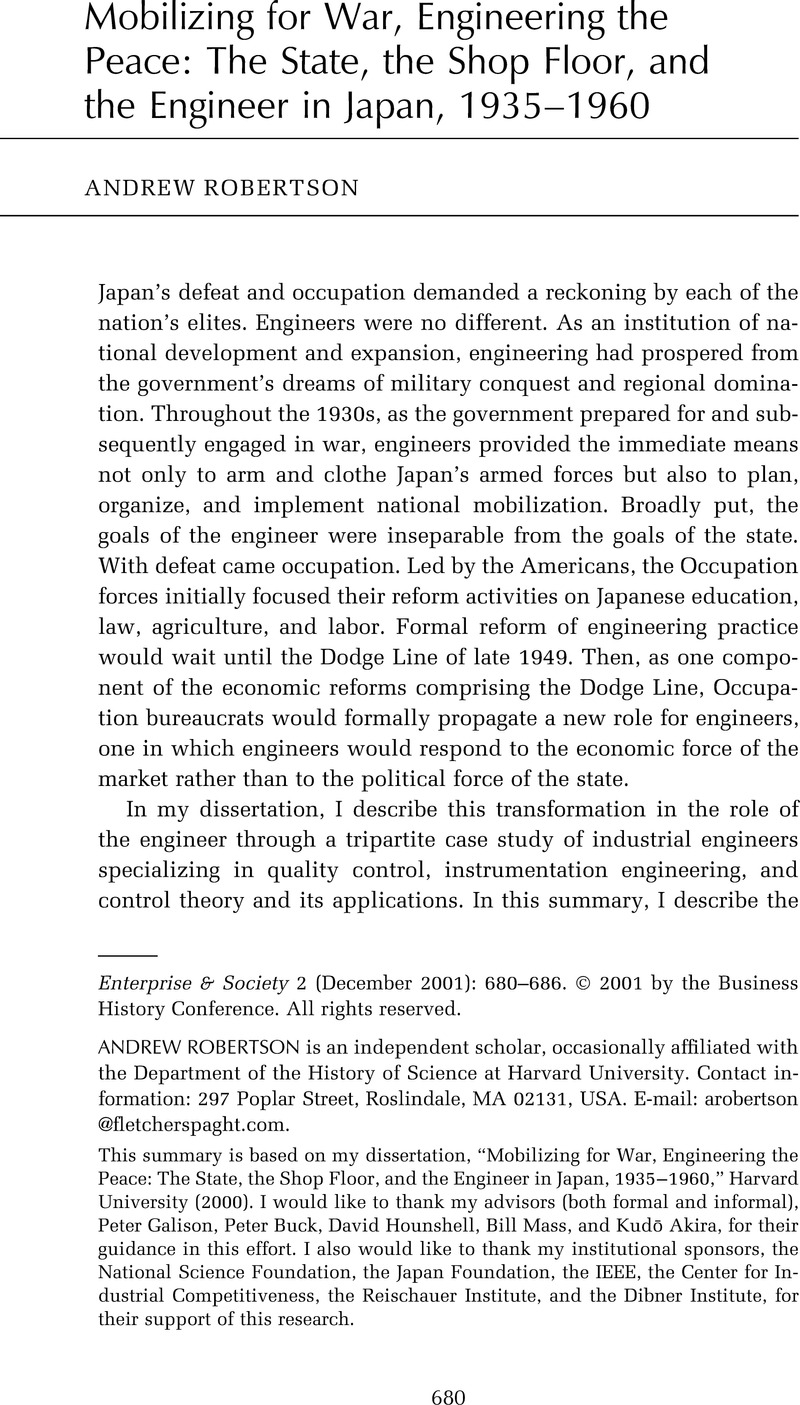No CrossRef data available.
Article contents
Mobilizing for War, Engineering the Peace: The State, the Shop Floor, and the Engineer in Japan, 1935-1960
Published online by Cambridge University Press: 18 February 2015
Abstract

- Type
- Dissertation Summaries
- Information
- Copyright
- Copyright © The Author(s) 2001. Published by Cambridge University Press on behalf of the Business History Conference. All rights reserved.
References
1. On the role of the engineer in the modernization of Japan, see Bartholomew, James, Science in Japan: Building a Research Tradition (New Haven, Conn., 1989), 126–30Google Scholar; on the systematic approach by which Japanese policymakers sought national security through development, see Samuels, Richard, “Rich Nation, Strong Army”: National Security and the Technological Transformation of Japan (Ithaca, N.Y., 1994), 93–98 Google Scholar; on wartime changes in production methods, see, for example, Wada, Kazuo, “The Emergence of the ‘Flow Production’ Method in Japan,” in Fordism Transformed: The Development of Production Control Methods in the Automobile Industry, ed. Shiomi, Haruhito and Wada, Kazuo (New York, 1995), 11–27.Google Scholar
2. Dower, John, Embracing Defeat: Japan in the Wake of World War II (New York, 1999), 80–84.Google Scholar
3. “Vacuum Tubes,” 10 Oct. 1946, box 3157Google Scholar, folder Memoranda for the Record #2C, Oct. 1946, National Archives and Records Service, GHQ SCAP Records, Record Group 331, 1.
4. For a relatively complete outline of wartime and postwar activities at the Electrotechnical Laboratories, see Iinkai, Henshū, ed., Denki Shikenjo Saikin no Jūnenshi (Tokyo, 1952)Google Scholar. For a complete discussion of the results of these experiments, see Seki, Takeo et al., “Hansōyō Gogyoku Shinkūkan no Kaizen ni Kan suru Kenkyū,” Denki Shikenjo Kinen Ronbushū (Tokyo, 1949), 200–10.Google Scholar
5. Koji, Kobayashi, “Hinshitsu Kanri no Jissai,” Kikai no Kenkyū 1 (Nov. 1949): 5.Google Scholar
6. For the background of the Dodge Line, see Allen, G. C., A Short Economic History of Modern Japan, 4th ed. (London, 1981), 190.Google Scholar
7. Sarasohn, H. M., “The Need for a Management Training Course in the Communications Manufacturing Industry,” 6 Aug. 1948 Google Scholar, box 3162, folder Memoranda For Record by Research and Development Division, 1 Jan. 1949 through 30 Apr. 1950, National Archives and Records Service, GHQ SCAP Records, Record Group 331, 1.
8. Tsutsui, William, “W. Edwards Deming and the Origins of Quality Control in Japan,” Journal of Japanese Studies 22 (1996): 314–15.CrossRefGoogle Scholar
9. The process by which these ideas infiltrated engineering practice in Japan is complex and occurred only gradually. As an example, consider the writings of NEC's top man Kobayashi Kōji, who, under the tutelage of the Occupation, in his writing from 1947 to 1949 moves from describing his wartime work as scientific and progressive to describing it as unscientific and irrational. Kōji, Kobayashi, “Hinshitsu Kanri ni Tsuite,” Seisan Nōritsu 2 (May 1947): 19 Google Scholar; Kōji, Kobayashi, “Wagasha ni OkeruKōjō Kaizen no Jissai,” Seisan Nōritsu 4 (Aug. 1949): 2.Google Scholar




